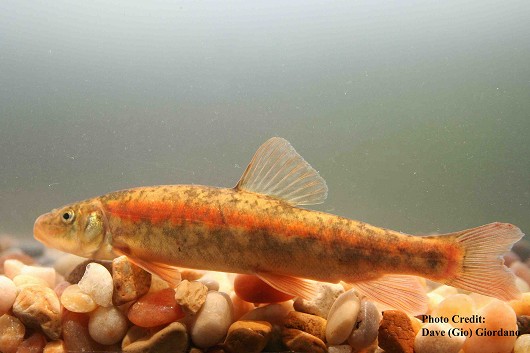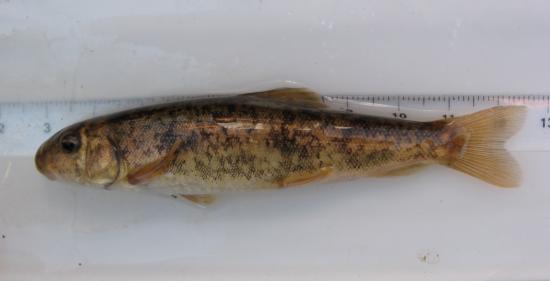Tahoe Sucker
-
Scientific NameCatostomus tahoensis
-
NativeYes
-
Identification
 Tahoe sucker, adult, approximately 15 cm (6”) long. Date: 7/8/2007.
Tahoe sucker, adult, approximately 15 cm (6”) long. Date: 7/8/2007. Tahoe sucker, juvenile, caught in Bogard Spring Creek (Eagle Lake watershed) in 2011. Photo by Teejay O'Rear. Scale in cm.
Tahoe sucker, juvenile, caught in Bogard Spring Creek (Eagle Lake watershed) in 2011. Photo by Teejay O'Rear. Scale in cm.- May exceed 60 cm SL in lakes, rarely exceed 15 cm SL in streams
- Subterminal mouth, lower lips incised, upper lips 2-4 rows of papillae
- Large head (head length about ¼ SL) with large snout (snout = half of head)
- Thick caudal peduncle
- Coloration: dark olive back and sides, white or yellow underside
- Breeding adults: lateral band (bright red in males), breeding tubercles on anal fin and tail
- Fin rays: dorsal 9-11, anal 7, pectoral 14-16
-
Life History
Tahoe Suckers are found in streams, lakes, and reservoirs of the northeastern Sierras. The suckers are found predominantly in cool streams though they are capable of withstanding temperatures in excess of 25°C. Juveniles suckers occupy slow shallow regions while the adult suckers live in deeper pools that provide ample overhead cover from predators. Suckers are omnivorous and adult fish tend to feed mostly at night on algae, detritus and various forms of benthic invertebrates. Younger suckers feed on cladocerans and other organisms found in or around algae and aquatic vegetation. In lakes the Tahoe Suckers grow to much greater sizes by foraging along the bottom, sometimes as deep as 300 m. Like the stream dwelling suckers, the lake inhabitants are omnivorous and consume various benthic organisms. In Lake Tahoe a sucker’s diet might consist of midge larvae, annelid worms, and amphipods. In other lakes their diet may include algae and crustaceans. Eagle Lake, California, is home to the fastest growing Tahoe Suckers, where 10 year old fish measure 30-35 cm SL. Tahoe Suckers spawn from March to August. Lake suckers may either breed in the lake or in a tributary stream depending on size. Fish less than 25 cm SL typically spawn in tributary streams while larger fish spawn in gravely or rocky areas of a lake when the water temperatures are 12-23°C. Stream suckers move upstream to riffles at night when water temperatures are within a range of 11-14°C. In these reaches the males spread out and await the females. When a female approaches a male’s “station”, he moves, spawns, and then repositions himself at his station. Mean fecundity in lake suckers is 20,555 eggs, assuming an average body length of 31 cm FL. Smaller females in streams produce fewer eggs. Seasons of sustained high flows seem to lead to a higher yield of production because the high water helps maintain protective habitat for larval and postlarval suckers.
-
Links to Other ResearchN / A

